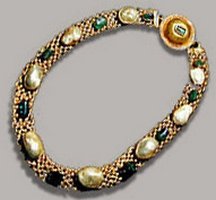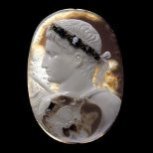Ancient Roman Jewelry: the Bvlgari of its time?
What could the jewellery of the ancient Roman Empire possibly have in common with Audrey Hepburn, Princess Grace of Monaco, Elizabeth Taylor and Keira Knightly?
The answer is two things:
- an unmistakable elegance of style, and
- Bulgari, the third largest jeweler in the world.
Founded in 1884, Bulgari (styled Bvlgari) is an Italian luxury brand, with stores worldwide but its headquarters firmly in Rome. One of the most revered of brands, it is known globally, particularly for its high end jewellery.
The company prides itself on producing some of the world's finest jewelry, worn by some of the world's richest and most elegant women.
Bvlgari is also proud to claim a heritage which bases many of its pieces on the traditions, cultures and designs of ancient Italy.
Compare the necklace worn by this well to do Roman woman (image courtesy of the VRoma project) with the Bvlgari gems worn by Kiera Knightley at the Oscars in 2006.
The resemblance is striking.
 |

|
| Kiera Knightley wears Bvlgari, 2006. | Necklace of Ancient Rome. |
And Bvlgari is not alone. Many present day Italian jewelers, recognising the fascination of modern cultures with ancient Roman fashion, take their inspiration from ancient Roman jewelry techniques and designs.
What makes Italian gold jewelry so sought after? And where - exactly - did it all begin?
Ancient Roman jewelry all started with the Etruscans.
Actually, it started before the Etruscans with the jewelers of Ancient Egypt - but that's another story.
The Etruscans fascinate, probably because we know so little about them. What we do know is that they flourished between the eighth and third centuries BC in the parts of Italy now known as Tuscany and Lazio, later spreading both north and south.
Sophisticated in their farming and trading methods and the developers of an advanced, complex system of writing, they equally enjoyed the finer things in life: music, good food, and exquisite jewelry.
A canny people, the Etruscans realised there was no point re-inventing the wheel and took many of their jewelry-making techniques directly from the cultures they traded with around the Mediterranean basin.
Greek, Egyptian and Syrian influences mix with everyday emblems and objects to form incomparable pieces which, although functional, were very elaborate.
Look for example at this brooch (fibula). Used to hold a tunic together the animals it portrays, probably lions, are shown in fine detail.

Now consider it was made in the 7th Century B.C., long before computer assisted design. The Etruscans perfected the most difficult techniques with the most basic of tools.
Two of those techniques later became immensely popular in ancient Roman jewelry making and remain a backbone of modern Italian gold jewelry design: granulation and filigree.
The granulation on Etruscan jewelry is so fine that it resembles gold powder, and working with it required enormous skill. Look at the earring below. Unlike the fibula, this piece of jewelry is no longer functional. The Etruscans had realised that jewelry could be used as both an adornment and an indication of wealth and status.
 |

|
| Etruscan filigree earring, 530 B.C. | Modern filigree earring. |
The patterns are incredibly intricate, formed from tiny twisted pieces of immensely fine gold wire (filigree) and tiny granules moulded onto a flat piece of smooth gold (granulation).
The coils of wire, diminutive gold petals and contrasting blue glass beads are set so that they must have shimmered and gleamed as the wearer moved her head.
Jewelry and the Ancient Romans: they came, they saw, they did it better.
Jewelry in ancient Rome at first followed the trends set by the Etruscans, using gold and glass beads. But as the power and spread of the Roman Empire grew, jewelry designs became ever more elaborate. The aim was both to incorporate different cultural styles from Europe, Egypt, North Africa and the orient, and to reflect Rome's prosperity as a dominant, conquering city.
The wide range of natural resources enabled its artisans to create ostentatious jewelry using a diverse selection of materials which increasingly included sapphires, diamonds, emeralds, garnet and amber from India, jet - from fossilised wood - from England, and, for the first time, pearls which were particularly prized.
The women of ancient Rome loved it!
Ancient Roman Jewelry - who wore what?

The upper classes.
In the world of ancient Rome a public display of status was essential - not so different from modern-day culture. Fashioned from gold and set with emeralds and large pearls this impressive necklace found at Pompeii is the kind of jewelry we know from wall paintings and pictures from ancient Rome was worn only by the more opulent women as a sign of wealth and prosperity.
Bridging the gap: cameos.
A direct forerunner of modern day designs, this cameo brooch would have been used to hold together a Roman tunic. Although functional, it was carved in intricate detail.
Initially using gemstones, later ancient Italian design was from cheaper materials such as shell and lava. This made jewelry both more accessible to the lower classes and a less formal piece of jewelry which could be worn during the day.
The forerunner of mass produced "costume jewelry" we know today, the design was less intricate and therefore less costly. Consider the detail on the ancient Roman brooch when compared with this 19th Century shell cameo.
 |
 |
| Cameo of Augustus, 1st C A.D. | Italian shell cameo, 1805. |
Earrings of gold ...
Earrings were particularly enjoyed by the women of ancient Rome. Early examples were made of gold, using the Etruscan granulation and filigree techniques. They ranged from simple hoop earrings, introduced to the world by ancient Roman goldsmiths, to later styles which were longer and more ornate, often reaching down to the neck - what we might now call 'chandelier' earrings.
 |

|
... and glass.

Glass makers from Syria and Palestine were brought to Rome around the 1st Century B.C. as the Empire grew. They were the first to discover the process of firing and blowing glass, and developed ways of colouring plain glass by adding minerals such as copper, iron, lead and tin to the molten glass.
Those discoveries made ancient Roman jewelry fashioned in glass available to everyone.

Glass earrings became fashionable amongst the lower classes as well as those of higher status. Brooches took on spectacular designs and colouring.
The citizens of the Roman Empire used more glass products than any other civilisation. Its modern day version can be seen in the massively popular glass industry of Venice, whose artisans still use many of those ancient techniques coupled with contemporary design.
Did men wear jewelry in ancient Rome?
If jewelry fashion for women dictated a need for ever more elaborate designs and new techniques, men in ancient Rome were not to be outdone.
Male jewelry may have been more functional than fashion statements in a number of different ways. But the Italian male has always been a 'fashionista', and men learned quickly to adapt the dictates of fashion to their own inimitable style.

If jewlery equalled wealth, what better way to show it than to use ancient Roman coins in its design? The use of coins in jewelry was not a Roman invention but their appearance in brooches, coins and necklaces becomes much more common in the Roman period.
For men, rings became the acceptable face of jewelry. They were seen as a major status symbol.

Generally made of gold, artisans learned to combine it with another metal - often copper - for strength, a technique still used in present day rings. They liked to incorporate coins or personal cameos which were used as seals.
These were the forerunner of our 'signet rings'.
Initially, fashion dictated one ring only should be worn but ancient art suggests fashionable men wore as many as one ring on each finger!
Ancient Roman jewelry did not include wedding rings but engagement rings - then known as 'betrothal rings' were first introduced in ancient Roman wedding culture.
Given by the groom to his bride-to-be at the point the couple decided to marry, it would later also serve as the wedding ring.
Men never wore either betrothal or wedding rings - they were purely a symbol of ownership by the man of the woman.
Signs and symbols in the jewelry of ancient Rome.
Men also wore jewelry as amulets or talismans. They were thought to bring good luck, or ward off ill-fortune. Until puberty young boys wore a gold pouch or 'bulla' on a neckchain. It would contain protective amulets, designed to ward off evil forces before they did any harm.
Roman jewelry used symbols in the form of talismans which were thought to attract energy to provide abundance, strength or immortality - the ancient equivalent of our rabbit's foot or four leaf clover.

Probably the most common of the ancient Roman symbols was the image of the coiled snake, used as a representation of immortality and particularly common in bracelets.
Some tomb sculptures show women with as many as seven such bracelets on each arm, presumably as extra security for the afterlife.
But snakes were not the only symbol to be incorporated into ancient Roman jewelry.
Fish were common as symbols of fertility or abundance, the eagle represented dignity and victory and was often carried into battle as an ensign, spiders represented foresight in business matters, and the 'cornicello' or horn protected against the 'evil eye'. It remains a potent symbol in present day Italian charm jewelry.
From ancient Roman jewelry to modern Italian culture.
 |
So Bvlgari began with ancient Roman culture.
When they chose to design their watch collection using snake bracelets, and when Keira Knightly wore Bvlgari jewelry at the Oscars, they were illustrating graphically the co-existence of ancient and modern cultures and traditions.
It's a feature of all modern Italian culture and the legacy of ancient Roman jewelry is far-reaching.
The culture of gold-working excellence has resulted in Italian gold jewelry being highly prized throughout the world. The granulation technique exists still in Tuscany, filigree work is common in Sardinia and Liguria, filigree methods used in glass working create the exquisite glass beadwork of modern day Venice.
Solid workmanship, elegant design, rich materials, jewelry which makes a statement by combining tradition and innovation to create the sheer force of its beauty.
Modern day Italy exports 4 billion Euros worth of jewelry each year.
And for that, we have the ancient Romans to thank.
Where to see original ancient Roman jewelry :
* The National Etruscan Museum, Rome
* Museo Gregoriano Etrusco, Vatican city, Rome
* Victoria and Albert Museum, London
* The British Museum, London
* The Metropolitan Museum of Art, New York.
All images on this page, unless otherwise specified, are courtesy of the VRoma.com project.








